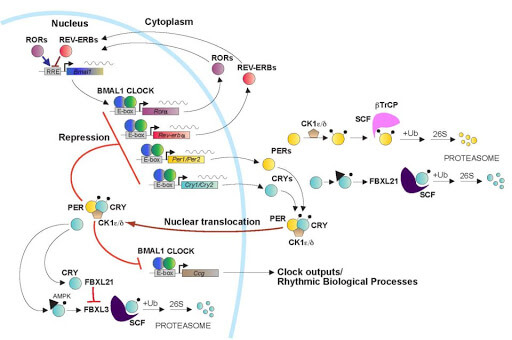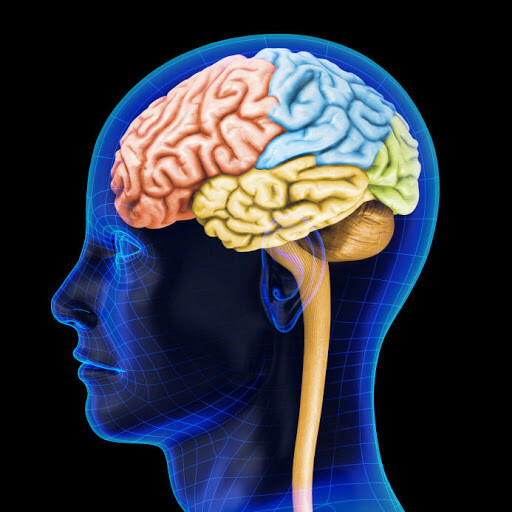– These are cyclic fluctuations in the intensity of physiological processes with a frequency of about 24 hours. They affect body temperature, heart rate, hormone concentration, metabolism, etc. Given that many dermatological diseases are associated with impaired tolerance of the immune system or a failure in a certain part of it, scientists have conducted clinical studies that describe the relationship of circadian rhythms and the strength of the response of the immune system. This kind of research can significantly increase the effectiveness of the treatment of chronic dermatoses, allergies and autoimmune diseases. Read on
estet-portal.com about the molecular genetic basis of biological rhythms, research on mechanisms of influence of circadian rhythms on the immune system and the body as a whole.
- Molecular Mechanism of Circadian Rhythms
- Circadian rhythms of the immune response
- Circadian Rhythm Research immunity: findings Molecular mechanism of circadian rhythms
Today, there is a clear understanding of the molecular genetic mechanism of the "biological clock". The main genes that regulate circadian rhythms are the
genes "period"; (periodic) and "timeless" (temporary). The periodic gene contains PER- a protein, cyclic fluctuations of which regulate human biological rhythms. The level of PER-protein increases at night and decreases during the day, due to degradation under the influence of external factors, including light, synchronously with circadian rhythms. The regulation of circadian rhythms occurs according to the feedback principle: when a sufficient amount of PER protein is synthesized, the protein blocks the activity of its own periodic gene, stopping the synthesis of mRNA and PER protein.

This protein is synthesized
in the cytoplasm of the cell, but it accumulates in the cell nucleus. The «timeless» gene contains protein TIM, which forms a complex with the protein of the temporary gene PER, protecting it from destruction and ensuring its delivery to the cell nucleus. When the complex of PER and TIM proteins enter the nucleus, they block transcription factors and, thereby, inhibit processes of transcription of genes «period» and "timeless". Gene «double-time' encodes the DBT protein, which influences the degradation of the PER-protein , slows down its accumulation in the cell nucleus so that the cycle of fluctuations in protein levels lasts 24 hours. Protein DBT prevents the synthesis of an excessive amount of the periodic gene protein in the cytoplasm of the cell. Thus, the protein DBT provides stability of circadian rhythms. slows down its accumulation in the cell nucleus so that the cycle of fluctuations in protein levels lasts 24 hours
. ProteinDBT prevents the synthesis of an excessive amount of the periodic gene protein in the cytoplasm of the cell. Thus, the protein DBT provides stability of circadian rhythms.
slows down its accumulation in the cell nucleus so that the cycle of fluctuations in protein levels lasts 24 hours. Protein DBT prevents the synthesis of an excessive amount of the periodic gene protein in the cytoplasm of the cell. Thus, the protein DBT provides stability of circadian rhythms. Follow us on Instagram! Another key gene for the regulation of circadian rhythms is the "cryptochrome
"gene, which encodes the photoreceptor protein CRY
.This protein reacts to blue and ultraviolet light by sending a signal about the level of light and time of the day to the brain. Also, the
CRYprotein regulates the synthesis of the protein of the temporary geneTIM
: it contributes to its degradation before dark.
Read also:Intermittent fasting clinical trials
The main regulator of circadian rhythms is located in the brain. All signals are transmitted to the epiphysis. It receives light level signals via the optic nerves from retinal ganglion cells. These cells contain photosensitive cryptochromic and melanopsin receptors. After receiving signals, the pineal gland releases the hormones melatonin and serotonin, which synchronize circadian rhythms in all cells of the body. Melatonin – sleep hormone, which is formed in the dark at night, while serotonin is synthesized during the day in bright light. Circadian rhythms of the immune response
In a review article appearing in
«
Trends in
Immunology» , researchers from the Biomedical Center of the Ludwig-Maximilian University of Munich and the Medical Faculty of the University of Geneva brought up for discussion the question of
features of the mechanisms of the daily control of the body's immune response. In their work, the authors analyzed a number of studies and clinical observations that examined the relationship between circadian rhythms and immune responses. The result was convincing evidence that adaptive immune responses, which are driven by the activity of highly specialized immune cells, are controlled by circadian rhythms. The researchers believe that such findings should be carefully considered not only in the field of dermatology, immunology and allergology, but also in clinical medicine in general, including their undoubted importance in a wide range of clinical situations −
from transplantation to vaccination.
Read also:How lack of sleep affects the skin The body responds to various stimuli, including changes in light patterns and fluctuations in hormonal levels, which makes it possible to predict the cycles of sleep rhythms, metabolism and a whole range of physiological processes. In both humans and animals,
blood leukocyte levelsare also driven by circadian rhythms. These data allow
to influence the immune system
 Skin Circadian Rhythms: Living on a Schedule is Now Fashionable
Skin Circadian Rhythms: Living on a Schedule is Now Fashionable
- Based on the analyzed data, the authors formulated a number of conclusions about the relationship between circadian rhythms and the immune response: Animal studies have shown that monocyte levels in the blood gradually increase over the course of the day. This allows for effective correction of diseases that are associated with pathological activity or defects in the work of monocytes.
- Among the conclusions of the study, it was noted that the ability of immune cells to be included in the counteraction processes may depend on CCR
2 − chemokine protein, which regulates the cascade of reactions of the body's inflammatory response. During the day, CCR2
levels peak in the morning, and judging by its effect on immune cells, a number of studies have observedchanges in leukocyte activity during this time period . Previously, the role of this protein in the development of chronic dermatoses, eczema, atopic dermatitis and chronic urticaria has been studied. It has also been proven that the manifestation of allergic symptoms are rhythmic and dependent on circadian rhythms. They increase in the interval between midnight and morning hours (4-6 am)
. Thus, the molecular "biological clock" control the physiological activity of immune cells, and therefore − and consequences of a wide range of allergic and autoimmune diseases.Detailed study of the
circadian regulation of innate and adaptive immunity is a powerful tool for fundamental understanding of the physiology of the interaction and sequence of immune responses that depend on the time of day. Clinical understanding of the molecular and genetic basis of circadian rhythms and their influence on the functioning of all body systems will lead to opportunities for the development of new specialized methods of treatment and effective correction of the therapy of diseases associated with both immune system disorders and other pathologies. More interesting videos on our YouTube-channel!






Add a comment